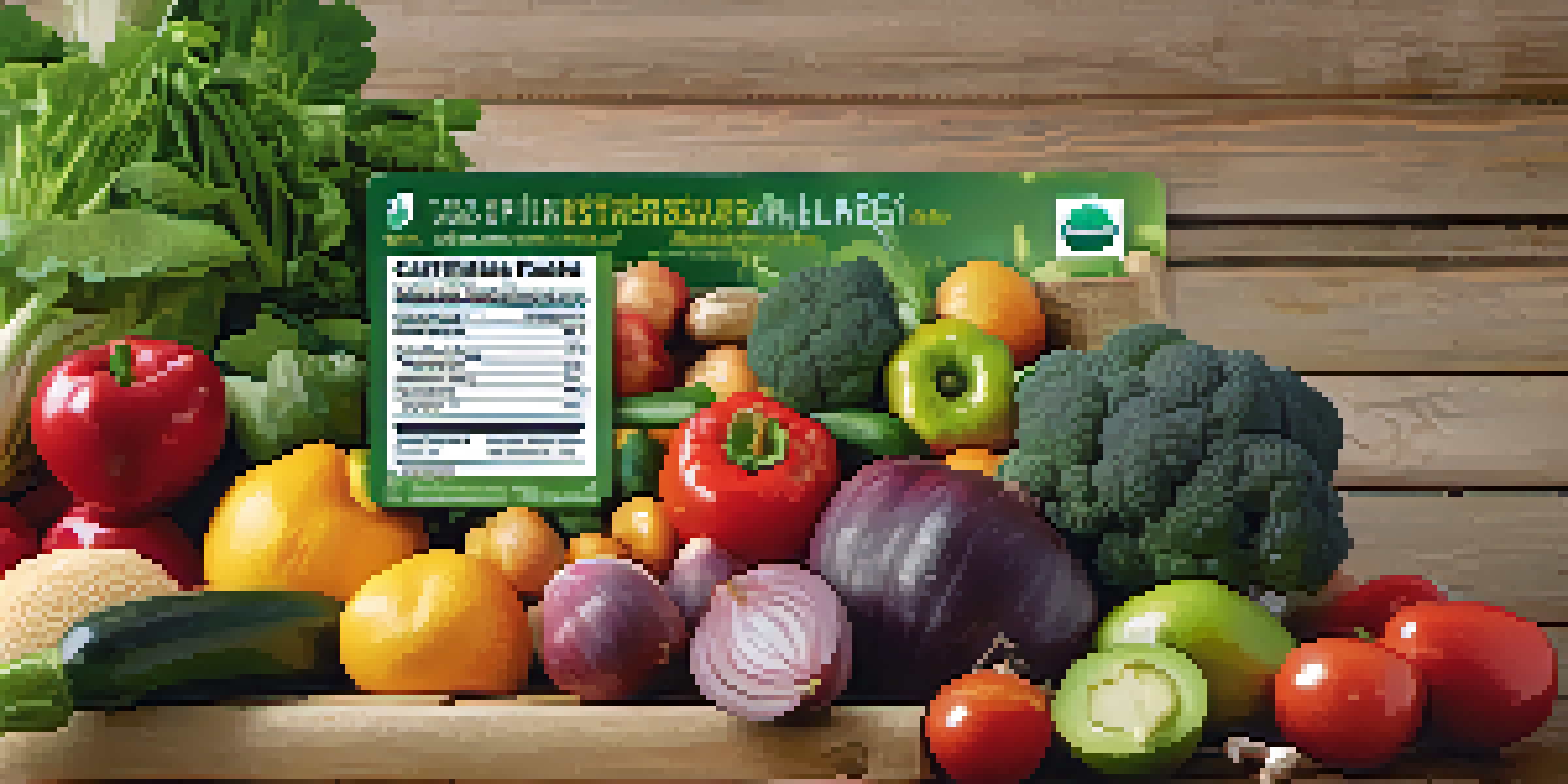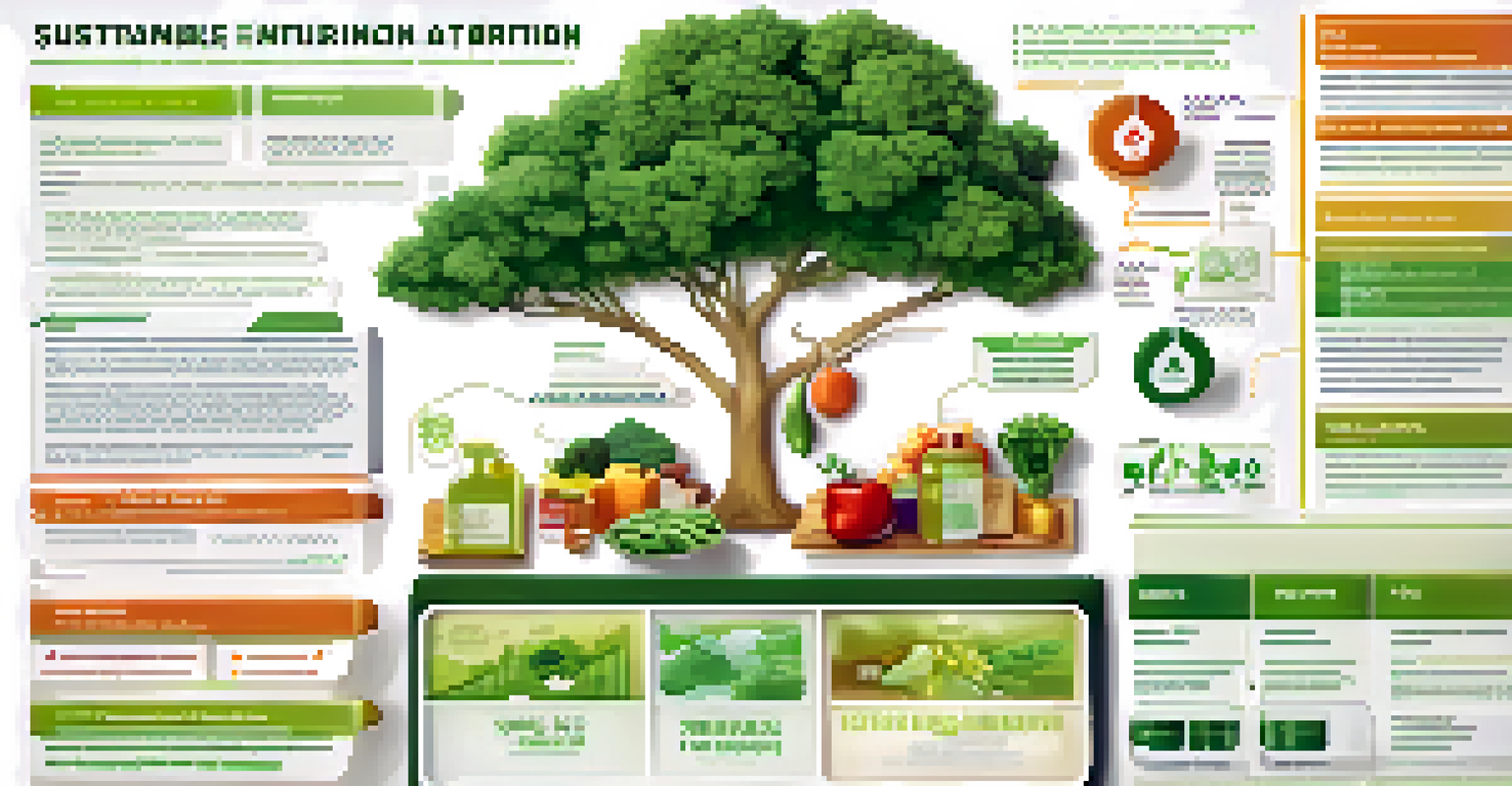Sustainable Nutrition Labels: What You Need to Know

What Are Sustainable Nutrition Labels and Why They Matter
Sustainable nutrition labels are designed to provide consumers with information about the environmental and social impact of their food choices. They go beyond traditional nutritional information, incorporating details about how the food was produced, processed, and packaged. This shift aims to empower consumers to make healthier and more environmentally friendly decisions.
Sustainability is no longer about doing less harm. It's about doing more good.
For instance, a label might indicate whether a product is sourced from local farms or if it uses sustainable farming practices. These labels can help consumers support brands that prioritize eco-friendly methods, ultimately contributing to a healthier planet. In a world where climate change is a pressing issue, understanding these labels can make a significant difference in our purchasing habits.
By choosing products with sustainable nutrition labels, consumers can actively participate in promoting sustainability. This not only enhances personal health but also fosters a collective movement toward responsible consumption. When we know more about the food we eat, we can make choices that align with our values.
Key Elements of Sustainable Nutrition Labels Explained
Sustainable nutrition labels typically include several key components: sourcing information, production practices, and environmental impact assessments. Sourcing details reveal where ingredients come from, which helps consumers gauge the freshness and sustainability of their food. Production practices highlight whether the food was grown using organic methods or if animals were raised humanely.

Moreover, environmental impact assessments provide insights into how the food's production affects our planet. This might include information on carbon footprints, water usage, and waste management practices. For example, a label might indicate that a product has a lower carbon footprint due to its local sourcing, which can be a game-changer for eco-conscious consumers.
Understanding these elements can help consumers make informed choices. By prioritizing products with more comprehensive labels, we can support brands committed to sustainability, ultimately leading to a healthier consumer market.
How to Read and Interpret Sustainable Nutrition Labels
Reading sustainable nutrition labels effectively requires a bit of practice, but it's easier than it seems. Start by looking for certifications or symbols that indicate sustainability, such as USDA Organic or Rainforest Alliance Certified. These certifications signify adherence to specific environmental and ethical standards, giving consumers more confidence in their choices.
The greatest threat to our planet is the belief that someone else will save it.
Next, pay attention to the details regarding ingredients and sourcing. Labels that specify local or seasonal ingredients often indicate a lower environmental impact. Additionally, look for transparency in production practices; labels that explain how food is made can enhance your understanding of its sustainability.
Finally, don't hesitate to do your own research on brands with sustainable nutrition labels. Many companies share their sustainability practices on their websites, allowing consumers to dive deeper into their commitments. By being an informed shopper, you can make choices that resonate with your values.
The Role of Brands in Promoting Sustainable Nutrition Labels
Brands play a crucial role in the rise of sustainable nutrition labels, as they are responsible for the transparency of their products. Many companies are now adopting sustainable practices and labeling them to appeal to eco-conscious consumers. This shift not only helps the environment but also aligns with the growing demand for responsible consumption among shoppers.
For instance, some brands source ingredients from sustainable farms, while others might focus on reducing packaging waste. By highlighting these efforts on their labels, they can attract consumers who prioritize sustainability in their purchasing decisions. This is a win-win situation, as it encourages brands to adopt better practices while also meeting consumer demand.
As consumers, we hold the power to influence brands through our purchasing choices. When we support companies that emphasize sustainability in their products, we encourage a broader movement towards responsible consumption. This collective effort can lead to significant changes in the food industry.
Consumer Benefits of Choosing Sustainable Nutrition Labels
Choosing products with sustainable nutrition labels offers numerous benefits to consumers, starting with improved health. Foods produced with sustainable practices often contain fewer harmful chemicals and additives, leading to healthier eating habits. Additionally, these products tend to be fresher and more nutrient-dense, enhancing overall well-being.
Furthermore, consumers who opt for sustainably labeled products contribute to environmental protection. By supporting brands that prioritize eco-friendly practices, we help reduce pollution, conserve natural resources, and promote biodiversity. This conscious choice fosters a healthier planet for future generations.
Lastly, there's a sense of community that comes with supporting sustainable brands. Many consumers enjoy connecting with like-minded individuals who share their values around sustainability. This sense of belonging can enhance the overall shopping experience, making it more fulfilling and rewarding.
Challenges in Implementing Sustainable Nutrition Labels
While sustainable nutrition labels are beneficial, there are challenges in their implementation that both brands and consumers face. One significant hurdle is the lack of standardization; different brands may interpret sustainability differently, leading to confusion. Without consistent criteria, consumers may struggle to compare products effectively.
Additionally, some brands may engage in 'greenwashing,' where they exaggerate or falsely claim sustainability to appeal to consumers. This can undermine the credibility of genuine sustainable products and erode consumer trust. It's essential for consumers to be informed and discerning when evaluating labels.
Finally, there's the challenge of accessibility. Some consumers may find it difficult to locate sustainably labeled products, especially in areas where such options are limited. Addressing these challenges is vital to ensuring that sustainable nutrition labels are effective and widely understood.
Future Trends in Sustainable Nutrition Labeling
The future of sustainable nutrition labeling looks promising, with trends indicating a growing emphasis on transparency and education. As consumers become more aware of the environmental impact of their food choices, brands are likely to respond with clearer, more informative labels. This shift could lead to a standardization of sustainability criteria across the industry.
Moreover, technology is playing a significant role in evolving nutrition labeling. Innovations such as QR codes can allow consumers to access detailed information about a product's sourcing and production practices with a simple scan. This level of transparency can enhance trust between consumers and brands, fostering a deeper commitment to sustainability.

Finally, as more consumers demand sustainable options, it's likely that regulatory bodies will step in to establish guidelines for sustainable nutrition labeling. This could lead to a more unified approach that benefits both consumers and the environment, making it easier for everyone to make informed choices.